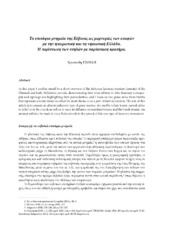| dc.contributor.author | Tsouli, Chrysanthi | |
| dc.date.accessioned | 2020-10-26T12:59:21Z | |
| dc.date.available | 2020-10-26T12:59:21Z | |
| dc.date.issued | 2017 | |
| dc.identifier.isbn | 978-960-85145-6-0 | |
| dc.identifier.issn | 2459-3230 | |
| dc.identifier.uri | https://hdl.handle.net/1956/24187 | |
| dc.description.abstract | In this paper I confine myself to a short overview of the Euboean funerary markers (semata) of the Classical and Early Hellenistic periods, demonstrating their close affinity to Attic funerary iconography and typology and highlighting their particularities, and I focus on two grave stelae from Eretria that represent a volute krater as either the main theme or as a part of their decoration. The aim of this article is to present an almost unknown type of grave marker, the marble volute krater, carved either in relief or in the round, as well as to trace its diffusion in mainland Greece and the Greek islands. An attempt will also be made to trace Euboea’s role in the spread of this rare type of funerary monument. | nob |
| dc.language.iso | ell | nob |
| dc.publisher | Norwegian Institute at Athens | nob |
| dc.relation.ispartofseries | Papers and Monographs from the Norwegian Institute at Athens | nob |
| dc.subject | Euboea Island - Archaeology | |
| dc.title | Τα επιτάφια μνημεία της Εύβοιας ως μαρτυρίες των επαφών με την ηπειρωτική και τη νησιωτική Ελλάδα. Η περίπτωση των στηλών με παράσταση κρατήρα. | nob |
| dc.type | Chapter | nob |
